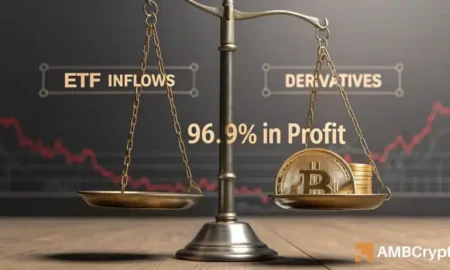Bitcoin Whales Accumulate Amidst Panic Selling: Signs of a Market Bottom?
In the volatile landscape of cryptocurrency, the behavior of Bitcoin (BTC) whales provides critical insights into market dynamics. Presently, we are witnessing a notable trend where larger holders are accumulating Bitcoin while smaller investors are selling off in fear, reminiscent of the 2020 bull cycle. This activity hints at the burgeoning possibility of a market bottom, as several key conditions coalesce, suggesting that Bitcoin could be gearing up for a significant recovery.
Fundamentally, a Bitcoin bottom often forms after a critical accumulation phase where strong hands absorb sell-side liquidity. During this period, larger investors, often referred to as whales, tend to increase their holdings, signaling a potential supply squeeze. With demand beginning to outstrip available supply in these accumulation zones, the market conditions are ripe for a robust rally. Recent on-chain data from CryptoQuant highlights this phenomenon: whales are on a buying spree, while smaller investors show signs of capitulation, prompting the question—could this trend indicate that the bottom is indeed in?
The market sentiment took a sharp turn recently as Bitcoin retraced to its pre-election low of $77,000, sending waves of panic through the investing community. Despite this turmoil, Bitcoin’s ability to hold steady above the $80,000 mark showcases its underlying strength. The upward resilience is not merely coincidental; rather, it is significantly bolstered by a spike in Bitcoin held by whales, particularly those with holdings between 1,000 to 10,000 BTC. Their accumulation is critical in absorbing market sell-offs, which provides a stabilizing force against deeper corrections and prevents prices from falling further.
A pivotal factor to consider is the sell-off risk lingering from short-term holders (STHs), which currently sits at a staggering $407 billion. An analysis by AMBCrypto indicates that many of these STHs bought Bitcoin at an average acquisition price of $95,138, with significant portions of that value now unrealized due to the current market price of approximately $83,000. As such, should these holders capitulate, we may witness an influx of sell pressure. The overarching question, however, is whether Bitcoin whales will continue to absorb this pressure, firmly establishing $80,000 as a critical support level.
Insights from past market cycles offer a beacon of hope. The current accumulation pattern amongst Bitcoin whales is reminiscent of the 2020 cycle, during which the cryptocurrency first broke past the $10,000 threshold. This marked the beginning of a breakout cycle that transformed market trajectories. During that time, data showed that whales were not only holding but actively accumulating Bitcoin. This trend hints that the same could be unfolding now, with minimal distribution observed among large holders, suggesting that they are prepared to absorb sell-side pressures as the market stabilizes.
Furthermore, supportive market dynamics are emerging, with robust U.S. buy orders and a downward trend in Bitcoin exchange reserves. This interplay between supply and demand is crucial. If these favorable conditions continue to develop, Bitcoin may well be on the brink of confirming a significant market bottom. In conclusion, as whales accumulate and smaller investors react to market fluctuations, the path forward for Bitcoin could be poised for an eventual resurgence, setting the stage for another potential bull cycle.
In summary, as Bitcoin whales continue to buy into the dips while fear prevails among smaller investors, the cryptocurrency could be on the cusp of a turning point. The parallels to the 2020 cycle, combined with current market dynamics, provide optimism that the established support levels will hold and pave the way for an upward trajectory in Bitcoin’s price. This unfolding narrative underscores the importance of monitoring whale activity and market sentiment as critical indicators of Bitcoin’s future performance.
















